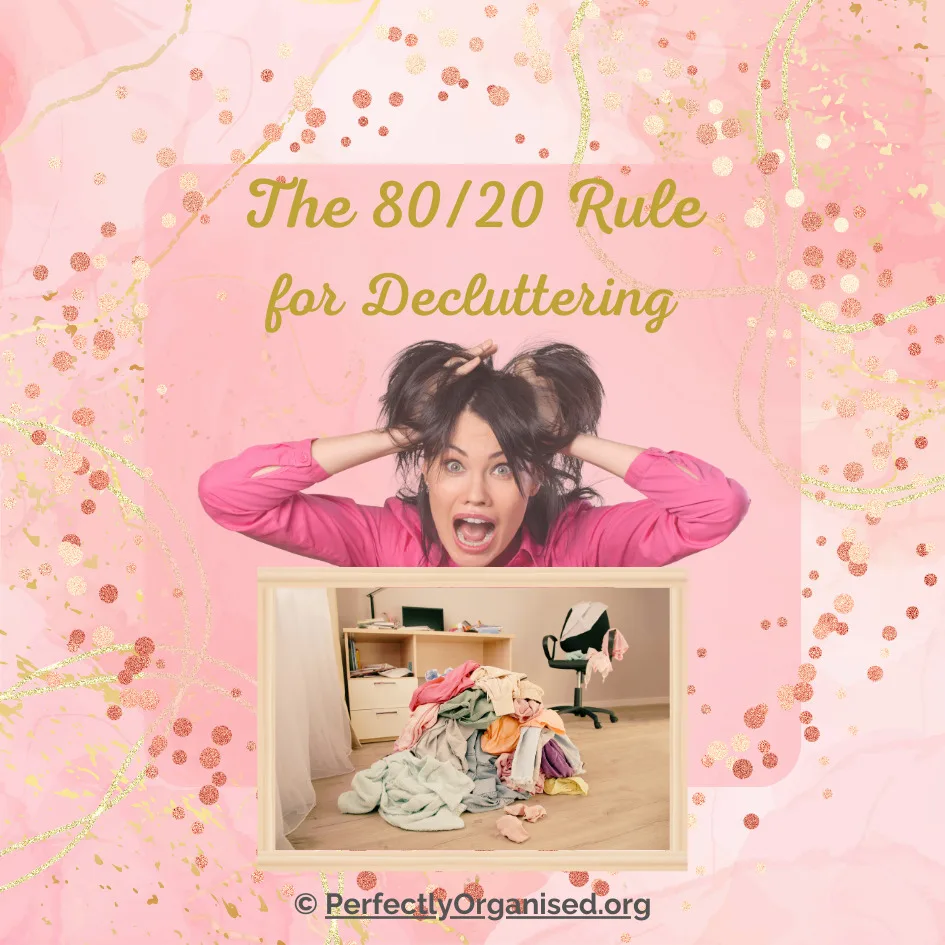There are many different methods for decluttering, but have you heard of the 80/20 rule? You can use this to declutter the things that matter most, the things that cause you the most stress.
Busy Bees Stop Here! What’s The 80/20 Rule?
Life can be extremely busy, and living in the fast lane means our homes can get cluttered really quickly. We get it, we really do. Your days are packed with work, places to be, things to do, people to drive around, meals to cook, etc etc. The last thing you need is a cluttered home adding to the chaos, right? But how can you avoid it?
A great way to de-clutter when you’re busy is by using the 80/20 rule. It can be a game-changing decluttering principle, and it’s loosely based on the Pareto Principle.
The Pareto Principle is well-known in the world of productivity. It states that roughly 80% of our results come from just 20% of our efforts. This simple yet incredibly effective principle helps us focus our efforts where they’re most needed. Consequently, this helps us make the most of our precious time.
How Could This Help Us When It Comes To Decluttering?
Translated into decluttering terms, it means that 80% of the clutter in our home comes from just 20% of our possessions. Let’s just take a moment to let that sink in.
Imagine if we could identify and tackle that 20% responsible for most of our clutter. We’d be able to free up space and create a more organised, stress-free environment.
Identifying Those 20% Culprits
The first step in identifying this clutter is to begin with the areas that bother us the most. Is it overflowing kitchen cupboards or a jam-packed closet? Or perhaps an uncluttered home office?
Grab a pen and jotter (or your notes app) and take a critical look around your home, and ask yourself the following questions about your clutter.
- What do I use regularly? Create a list of the things you use daily or weekly – these things need to stay.
- Which items hold sentimental value? Sentimental items are fine, but they don’t need to clutter your everyday space.
- What can be replaced easily? Some items (usually low cost ones) are replaceable if need be, making them candidates for decluttering. (We’re not advocating buying cheap necessarily, because quality should always trounce quantity.)
As you go through your inventory of possessions, you’ll probably start noticing that a small percentage of items fall into the first two categories. Everything else belongs to the 20% that’s causing the majority of your clutter. It’s these items that you should be able to get rid of.
Now It’s Time To Declutter Strategically
We’ve now pinpointed the culprits, so how do we go about decluttering strategically?
Start with high impact areas: the spaces where clutter causes you the most stress or inconvenience. It could be kitchen worktops, the dining room table, your bedroom floor or any other clutter hot-spot in your home. Take photographs of each area if you think that will help you identify your clutter spots better – some of us can be blind to our clutter, but seeing a photograph of the space can be an eye-opener.
Next, as with most decluttering methods, you need to sort your items into three or four categories. These should be: keep, donate/sell or trash. Be as ruthless as you can with the possessions you believe you can live without.
Use A Timer
It’s well known that setting a timer can make us extra-focused on any task, so set a timer for 15-30 minutes and use that time to declutter in a focused burst! This makes the process efficient and prevents overwhelm, making it all feel more manageable.
Consistency in Decluttering Is Key
To really make a success of this method, consistency is key. Create a new habit of dedicating a few minutes every day to decluttering. Additionally, add a couple of hours at the weekend if you’re able, when you can really make a difference to some of those piles. Doing it regularly means you’ll see results quite quickly.
Clutter weighs us down, which means as we’re letting things go, we begin to feel lighter. By getting rid of the majority of your unwanted stuff, you’ll feel a metaphorical weight being lifted off your shoulders.
Embracing Liberation From Clutter
Once you’ve said goodbye to your clutter, you’ll notice a few things. Firstly, you’ll be able to find things more easily – especially if you follow the ‘a place for everything, and everything in its place’ rule. Your home will look tidier, and you’ll have more space to breathe. And don’t forget, you’ll also have less stuff to look after, meaning less cleaning time, too! #winwin 😉
If you’ve ever been embarrassed about people seeing your home because of all the clutter, you may find you start getting more visitors. You’ll be sending out a positive vibe and drawing people to you, even if it’s subconsciously. Also, you will probably want to have people round to show off (in a good way) your lovely home. And people will be more likely to come, because who wouldn’t want to spend time in a well-ordered, calm, clean and tidy space?
And Finally …
The 80/20 rule is your secret weapon to declutter what matters most, and reclaim your time and your sanity. Remember that it’s all about efficiency, focussing on what matters most, and letting go of the rest.
Don’t let your clutter weigh you down. Instead, take charge and be in control of it, and enjoy the wonderful, liberating feeling of living a clutter-free life.

Recommended reading: The Clutter Connection: How Your Personality Type Determines Why You Organize the Way You Do
Disclaimer
This post contains affiliate links – please refer to our disclaimers for details on how this may affect you.
